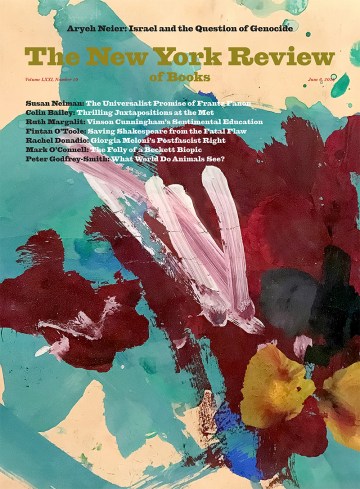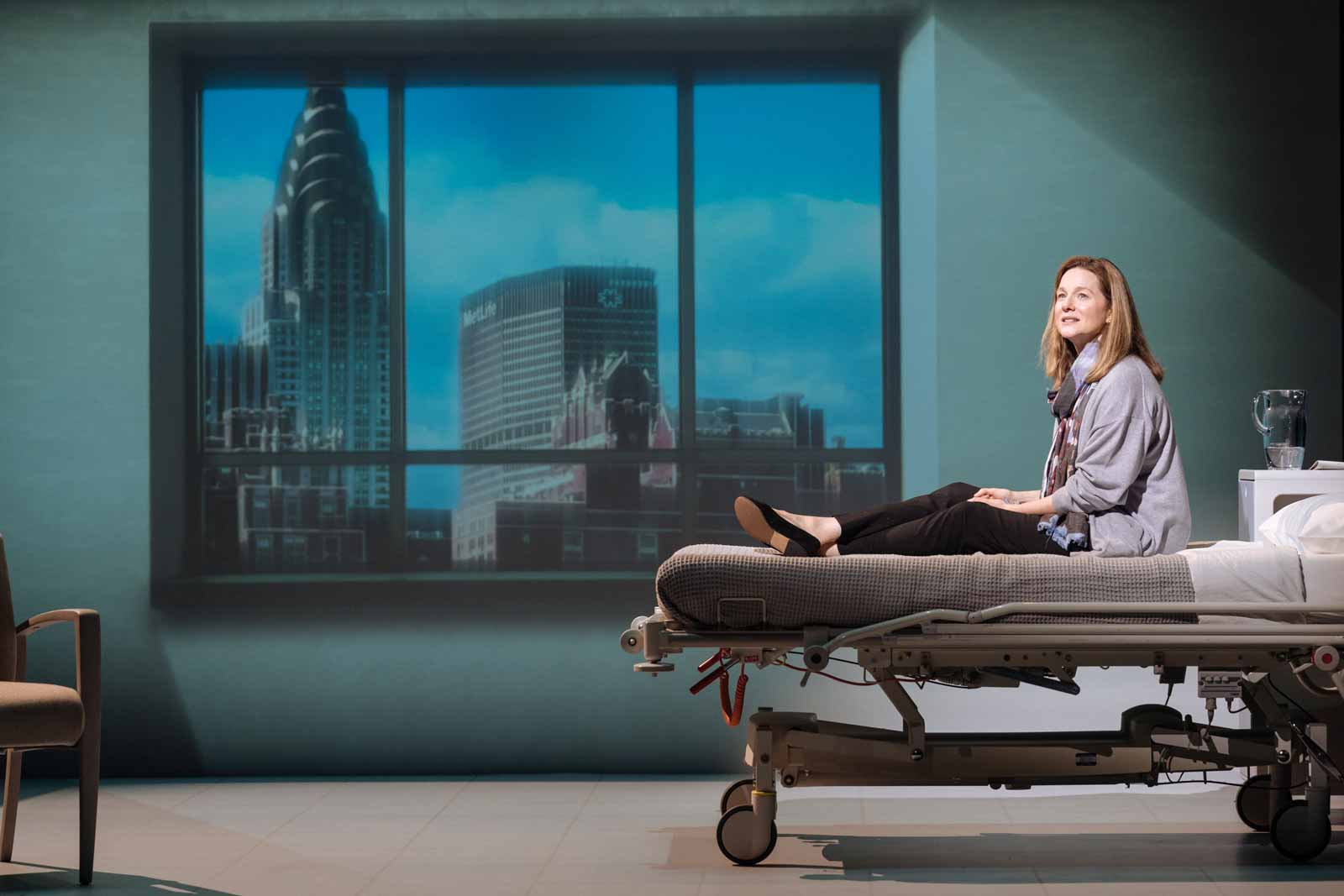“Lonely was the first flavor I had tasted in my life, and it was always there, hidden inside the crevices of my mouth, reminding me.” Re-reading Elizabeth Strout’s breathtakingly exquisite novel My Name is Lucy Barton in preparation for seeing the theatrical adaptation—directed by Richard Eyre and starring Laura Linney in her British stage debut at London’s new Bridge Theatre—I found myself knocked sideways by these lines. Strout’s titular protagonist-narrator is a writer whose existence has been defined by a loneliness so acute it can only really be understood as a chronic disability. Fitting, then, that the narrative Lucy tells as she looks back on her life pivots on a period of serious illness. “There was a time, and it was many years ago now,” she begins her story, “when I had to stay in a hospital for almost nine weeks.” This was in Manhattan in the 1980s, due to complications following what should have been a routine appendectomy. At the heart of the experience is the five days Lucy’s all but estranged mother spent sitting vigil by her daughter’s bedside.
My Name is Lucy Barton is a story about the harrowing legacy of poverty and abuse. Despite having left the world of her childhood behind—she escaped her impoverished life in the small rural town of Amgash, Illinois where she was born and raised, first to college, and thereafter to New York City, where she married and had children, going on to become a writer—as Lucy’s story unfurls, we learn that the punishing ostracization she endured as a child was the defining experience of her life. Hers was a childhood spent “friendless” and “scorned,” her family looked down upon because they were so poor and often so strange. Life at home was no easier, neither of her parents were able to express the love their children so clearly needed, and Lucy and her siblings lived in fear of the abuse they periodically suffered at the hands of their mentally disturbed father, a man left traumatized by his experiences as a soldier in WWII. This early deprivation has long-lasting effects. As an adult, Lucy’s less able to make meaningful connections with those around her, and all the more sensitive to the smallest acts of kindness.
The thrust stage, surrounded by the audience on three sides, is bare but for a single neatly made hospital bed, bedside bureau, and lone hospital armchair. Such static, understated minimalism sits in sharp contrast to the innovative use of the same space employed in the theatre’s much lauded recent production, Nicholas Hytner’s Julius Caesar, in which the stage flooded over into the stalls, the standing audience therein part of the action. There’s no such activity in this performance. Linney as Lucy Barton is the only cast member, the play a ninety-minute soliloquy. The only props are a jug of water and a glass—which Linney sipped only once during what must be an exhausting performance—and a magazine.
The wall behind her—three white rectangles of increasing size, each laid on top of the other—is a makeshift screen for kaleidoscopic video projections, illustrative backdrops for the various scenes from her life that Lucy recalls. A row of brownstones shimmers into focus when she speaks about the apartment that she shared with her husband and their two small daughters. Gently undulating rows of corn, as far as the eye can see, or a lone tree on an otherwise deserted prairie emerge when she reminisces about Amgash, along with the dark, dirt-streaked interior of the truck her parents used to lock her inside. Most memorable, though, is the play’s opening image of the window in the hospital room, through which we see a rendering of the Manhattan skyline, the Chrysler Building looming large—evocative of one of Edward Hopper’s famous cityscapes, “the signature images of isolation in the city,” as the writer Olivia Laing described the artist’s now iconic scenes in her own haunting study, The Lonely City: Adventures in the Art of Being Alone. Linney’s entrance transforms the composition into an imaginary lost Hopper oil, Hospital Room.
It’s revealing that one of the earliest connections Laing makes in her book is between loneliness and illness. “Like depression, like melancholy or restlessness,” she explains, loneliness “is subject too to pathologisation, to being considered a disease.” Lucy’s condition remains enigmatic. “No one could isolate any bacteria or figure out what had gone wrong,” she explains towards the beginning of her story. She runs fevers, internal blockages are suspected, she has no appetite, can’t keep food down, and thus loses a concerning amount of weight. Yet the tests come back negative, the scans are inconclusive. Undiagnosed, she’s a medical mystery.
Advertisement
It’s impossible not to wonder whether such a troubling array of seemingly inexplicable physical symptoms could be rooted in a psychological cause. The temptation is to diagnose the disease from which she’s suffering as that of loneliness itself. In The Lonely City, describing her own nomadic interlude spent in various solitary Manhattan sublets, “inhabiting loneliness on a daily basis,” Laing experiences her own unsettling physical decline: “I stopped eating very much and my hair fell out and lay noticeably on the wooden floor, adding to my disquiet.” In an act of apparent kindness that’s actually a sentence of solitary confinement, Lucy’s husband, uncomfortable around sick people himself, pays for his wife to have a private room. No wonder she takes so long to get well.
As if to reinforce this connection between illness and isolation, infection and disease pervade Strout’s prose. There’s the fatigued, jumpy writer, Sarah Payne—her surname a metaphorical nod to her daily suffering as she too is someone who finds the demands of ordinary daily interaction with others a struggle—who encourages Lucy in her work. After reading an early draft of Lucy’s book, she offers the then aspiring writer invaluable advice about staying true to her subject matter: “if you find yourself protecting anyone as you write this piece, remember this: You’re not doing it right.” Lucy’s father’s untreated PTSD, the source of a malaise during her upbringing in a family she describes as “unhealthy,” isolates both him and his family from the wider community around them.
And then there are the physical indignities and torments of AIDS that Lucy recalls witnessing, an illness that, for her, symbolizes an uneasy balancing act between kinship and segregation: the patients dying in their hospital beds—confined to lone rooms because of the fear of contagion—whom she glimpses through half-closed doors, and the “bony and gaunt” men she remembers seeing walking the streets of the West Village after she’s eventually discharged. “I know it’s terrible of me,” she recalls confessing to her friend and neighbor Jeremy—a man who will soon succumb to the illness himself—“but I’m almost jealous of them. Because they have each other, they’re tied together in a real community.” In the immediate aftermath of her illness Lucy was so thin that she was erroneously taken for an AIDS victim herself—a cruel mistake given the lack of sympathy this engenders in others, more of the same stigmatization she’s known since childhood.
One of the achievements of the novel is its portrait of reticence and inhibition. There is much Lucy simply does not know, more than the lack of common knowledge her husband tenderly explains away when she finds herself tripped up: “My wife’s parents were strict and never let her watch television.” There are aching voids of meaning in her world. These silences, absences, and ellipses shape the text, both in the narrative Lucy presents of her life and the bedside conversation between her and her mother, each woman damaged to the point of voicelessness, unable to speak about the darkest days of their shared past, along with the additional pain Lucy suffers due to her mother’s lifelong inability to tell her daughter she loves her. So, too, we learn that Lucy’s father never speaks about what he saw during the war. It is hardly surprising, then, that after a lifetime of being taught to repress and suppress, Lucy is still unable to vocalize her trauma even when she finally seeks help from a therapist; instead, she turns to writing down the details she “could not say.”
Each time I read the novel, I find myself wondering whether Lucy’s mother’s visit is the product of her daughter’s confused mind. “I was in a very strange state—a literally feverish waiting—and I really agonized,” Lucy admits at the beginning of her narrative, casting a veil of doubt over the account to come. True or not, it is in the story Lucy tells about those weeks that she finds the comfort she needs. “This is a story about a mother who loves her daughter. Imperfectly. Because we all love imperfectly,” Sarah Payne observes when she reads Lucy’s work.
In many ways, some strikingly clear and others tantalizingly oblique, this is a story that’s as much about what’s not there and what’s not said as what is; the novel embraces this ambiguity in a way that a stage production, with its necessary dependence on presence, is unable to rival. Some of this detail is simply absent from the script, although Rona Munro, who adapted the novel for the stage, does an admirable job retaining as much of the original story and language as possible. But where the play fell flat for me is that Linney delivers a powerhouse of a performance. Alone on the stage for an hour and a half, there’s nowhere for her to hide, and she bracingly shoulders that weight from the moment she first strides forward into our company, confidently launching into her monologue. But she remains Laura Linney throughout, she never transforms into Lucy Barton. Lucy is all quietness and unease; Linney, meanwhile, commands the room.
Advertisement
Nuances are lost in translation. Linney’s occasional side-eye to the audience, integral, no doubt, to building a rapport with the room, felt wrong considering Lucy’s guilelessness. The same can be said of Linney’s larger-than-life portrayal of Lucy’s mother—of all the characters who people Lucy’s story, it’s only the mother whom Linney regularly fully switches into character for—the loud, rasping drawl too often played for laughs. The audience responded eagerly; but I was lost. The story Lucy tells is about not being seen, but when Linney’s on the stage, it’s impossible to look away.
My Name Is Lucy Barton has been at the Bridge Theatre through June 23.




